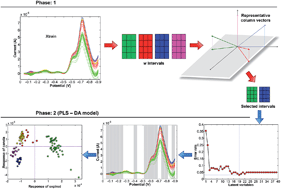The successive projections algorithm for interval selection in partial least squares discriminant analysis
Abstract
This paper proposes a new interval selection approach for PLS-DA modelling, which is developed as an extension of the recently introduced iSPA-PLS method for multivariate calibration. The proposed iSPA-PLS-DA algorithm is tested in two case studies concerning the classification of five types of vegetable oils employing square-wave voltammetry and the classification of five species of bacteria (Escherichia coli, Enterococcus faecalis, Streptococcus salivarius, Streptococcus oralis, and Staphylococcus aureus) using digital images. For comparison, the iPLS-DA algorithm for interval selection is also employed, in standard and backward modes. In both case studies, iSPA-PLS-DA provided correct classification rates larger than or equal to those obtained by PLS-DA using all variables and iPLS-DA with single or multiple intervals.


 Please wait while we load your content...
Please wait while we load your content...